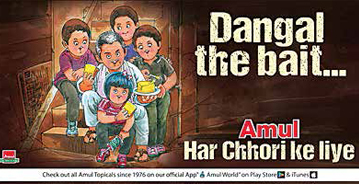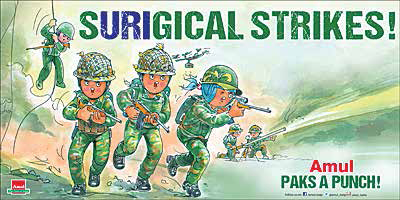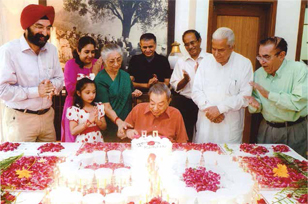
We all know Amul is India’s best food brand that stands for quality, but not many know what it takes to be the best. Rupinder Singh Sodhi, Managing Director of Gujarat Cooperative Milk Federation, which sells dairy products under the Amul brand reveals why, in spite of all odds, Amul is a leader of India’s dairy industry. Corporate Citizen brings you excerpts from his recent talk in Delhi that offers valuable marketing lessons and insights into India’s journey from a milk-deficit nation to the world’s largest milk producer
A man with a mission, Rupinder Singh Sodhi loves to call himself a doodhwala (milkman). He is a very humble product of the first batch of Gujarat’s prestigious Institute of Rural Management, Anand (IRMA) and is still in his first job! Beginning his career as Senior Executive (Sales) at Amul’s corporate headquarters at Anand, he hasn’t moved anywhere in the last 35 years. He heads India’s largest food products marketing organisation with an annual (2014-15) turnover of over $3.4 billion.
Soaring through the ranks of Amul, he went up the ladder by working on various positions in the Sales, Marketing, Commercial, Purchase and such other departments. He is one of the few who have had the opportunity to work directly under the Late Dr Verghese Kurien who established the Amul cooperative and is better known as the Father of the White Revolution in India for his Operation Flood, which made India world’s largest milk producer
Having learnt how to run the world’s greatest agricultural dairy development programme from the Master himself, Sodhi continues with the DNA instilled within Amul cooperative movement that believes in giving millions of dairy farmers of Gujarat the best price for their milk, while also ensuring the value for money to its committed consumers. Till 2010, Sodhi was procuring milk only from Gujarat’s farmers and selling products all over India. But his operations have lately extended to many other states including Rajasthan, Haryana, UP, West Bengal, Maharashtra, MP and most recently, Punjab. Now almost 20% milk comes from outside Gujarat. No wonder, his love, passion and drive to constantly improve these operations reflect in abundance when he talks about the basic ideas and beliefs that propelled this cooperative movement, wherein three fourths of the price you pay for Amul’s products goes directly to the farmers who own it.
On the other side of the supply-chain are the consumers who also have trusted this brand because we’ve been giving them pure and tasty products for the last 70 years. Food products have to be tasty and made from best technology and unarguably, Amul has, the most scientifically advanced technology"

No doubt, Amul is an iconic and ageless brand but you’re aware of only one face of Amul and if I’ve to describe it in today’s business language, it’s what you call C to C which means Cow to Consumer. So, its second face is that of our 3.6 million farmers, Amul brand is their only source of livelihood and women’s empowerment because 82% of them are landless or small and marginal farmers. So, if we’re growing and recognised as the most popular food brand today, it’s all because, their trust and faith in this brand is intact for the last nearly 70 years.
On the other side of the supply-chain are the consumers who also have trusted this brand because we’ve been giving them pure and tasty products for the last 70 years. Food products have to be tasty and made from best technology and unarguably, Amul has, the most scientifically- advanced technology that helps it deliver value for money to its consumers.
Dr Verghese Kurien, our founder-chairman used to say: “Marketing is not for business but for the development of the most under privileged of our society.” So, our marketing strategy is not aimed at business only but Amul is a tool for empowering the poorest of the poor farmers. Kurien also advised us not to underestimate the intelligence of our consumers. So, you’ve to see the positioning of brand Amul in that context.

Many people know that with 150 million tonnes annually, India is world’s largest producer of milk today and accounts for 18.5% of world production, but not many know that we’re also the world’s largest consumers! Fortunately, the world’s biggest market of milk and milk products exists in India only and it’s growing at a much faster pace than the world market. So, we’re very fortunate that we’ve a product which will keep growing and will be there for as long as there are human beings who have got stomachs.
There is some more data: World’s milk production is around 800 million tonnes, and the organised sector accounts for only 20%, thus the remaining 80% of milk is still used in the unorganised sector. So, there is enough scope for everybody to grow in this market. But India’s situation was not so, about 60 years back. We were importing dairy products like other countries around us—Pakistan, Sri Lanka, Nepal and the rest. While we’ve become the largest producer of milk, they’re still milk-deficit and importing.
In fact, during mid-1940s, there used to be huge exploitation of marginal milk farmers by the British agents of the only existing dairy, the Polson Dairy, who would arbitrarily decide the price of milk. Angered by this extremely unfair trade practice, the dairy farmers of Kaira village in Gujarat approached Sardar Vallabhai Patel and he clearly told them: “If you want the best price for your milk, you should form cooperatives and not only produce milk but also process and market it. If you could market it yourself, then only you can get maximum share of the consumer market.”
So, the original inspiration for Amul came from none else but Sardar Patel who also gave them the business strategy - supply milk directly to the Bombay Milk Supply Scheme instead of giving it to Polson who did the same but gave very low prices to the Gujarat farmers.
So, from that day in 1946, with just 250 litres of milk and two small village cooperative societies, operations started. Milk collection was decentralised and cooperatives were formed for each village. The biggest triumph was that we could get access to the Bombay’s milk-deficit market. We got the contract from the British Army in 1946 and continued with that. Milk was transported through railways to Bombay and then for other markets. In 1949, Patel sent Dr Kurien to look after its affairs. Seeing Patel’s efforts and the farmer’s trust in him, Dr Kurien felt inspired and dedicated himself to establishing the Amul Co-operative Dairy. Soon, we started using western technology and gradually began introducing more and more products as the times and needs demanded.
Today, 68 years later, Amul is India’s biggest brand having a worth of around Rs. 33,000 crores. From just 250 litres in 1946, we’re now collecting 220 lakh litres of milk per day from 3.6 million farmers and 82% of them live below the poverty line. Mind you, it’s not owned by any individual or government. It’s owned by these 3.6 million farmers of Gujarat and their hard work is what really works for this brand. And, that’s an inspiring tale for everyone.

Now, if you look closely into this strategy, it’s diagonally opposite to the business strategy of any other corporate house in India and the world. CEO of any corporate house will like to buy the raw material at as low price as possible but would like to sell the finished products at as high price as possible in order to earn maximum profit. But in Amul, the mandate given to me by the Board is totally opposite. They want me to buy raw material (80% of our cost is milk) at the highest price possible because I’m buying it from our owners. And, sell the finished products at the lowest and most reasonable rate so that our consumer base keeps expanding. Whatever milk we sell, 86% of the sale price goes to milk farmers. For other value-added products, where packaging and other duties come in, it may be as high as 80% which means if we sell any product at Rs. 50, Rs. 43 goes to the farmer. In the US, milk farmers get only 38% of what the consumer pays and in UK, it’s even less.
Another contradiction is, we cannot refuse to purchase milk from our farmers. In fact, we encourage them to improve productivity. In any other company, they procure and produce as per market demand. But in our case, it works the other way round. I cannot say, Bhai, I won’t buy your milk because today there is slackness in market or demand has dropped because of demonetisation. Whatever price is offered, I’ve to buy it, convert it to value-added products, and sell at such a price that millions of consumers happily buy it and feel happy after consuming it because then only they’ll come back.
So, milk procurement is a 365-day job. Milk supplies cannot be stopped. Whether it’s Eid or Diwali or strike or demonetisation, we’re working because cows and buffaloes cannot stop giving milk and we also cannot stop consuming morning tea or milk. No Amul factory is ever closed. They’re all in continuous operation because our basic philosophy is value for many (which means 3.6 million farmers or Amul’s owners) and value for money (for millions of Amul’s consumers). So, if we’re Number One in dairy business today, it’s because of this business philosophy, which is based on faith and trust.
Faith and trust in the brand is like religion for us. We believe that you’ve to show it in your business ethics. You just can’t make promises claiming I’m this and that or I’ll do this for you. You’ve to show the evidence. To give you just an example, there has been an average increase of 11% in the milk procurement prices in the last 10-11 years and Amul’s prices reflect just that. No wonder, we’ve delivered whatever we promised with the best of products made through the best of technology and with quality delivery.

When I say we give best quality product, it doesn’t mean what it was 50 years back. Most of the times, what happens is that if your brand is successful, you get the major market share like we’ve got more than 90% of the market share in butter. So, the next job of any CEO would be: how to reduce the cost of production? Now, in food products, you can do it by replacing the expensive food ingredients with cheap synthetic ingredients or chemicals and, in fact, many companies are doing this. Those who want to make a quick buck in dairy business compromise their quality by replacing dairy fat with the vegetable fat which is 1/4th of the total cost because ultimately their business objective is to reduce the cost of ingredients and increase the profit margin.
But, at Amul, composition of our products is exactly the same. For example, what our butter was 60 years back, it’s still the same. Not a single change has taken place in its recipe. Same is true for our milk powder or cheese or ice-cream or chocolate or any other product. This is in spite of tough competition that we face in the market and because Kurien used to tell us: Never think you’re smarter than the customer. Always think, he’s smarter and you cannot outsmart him.
Today I’m selling one kg of baby milk powder at a certain price but because of advertising costs, if tomorrow, I’ve to increase the price, what will I do? In this situation, most of my competitors will reduce the weight by 50/100 gms so that their milk powder continues to sells at the same price, though with a little less weight. But Kurien has taught us: If you try to cheat customers by employing short-term marketing strategies, the day they’ll come to know of it, they’ll certainly lose their faith in your company.
When I say we give best quality product, it doesn’t mean what it was 50 years back. Most of the times, what happens is that if your brand is successful, you get the major market share like we’ve got more than 90% of the market share in butter. So, the next job of any CEO would be: how to reduce the cost of production"

In dairy business, setting up plant and machinery is the easiest thing but building a brand is very difficult because brands are different from products in a way that brands are what the consumers buy while products are what companies make. Moreover, brands cannot be created only by marketing or advertising. Everyone knows how to make butter, cheese and ice-cream but brand building requires winning the confidence and trust of your consumers. Brand is a promise that the product will always stand true to consumer’s expectations and that’s a tall promise. Second is operational difficulty of building a distribution network for fresh, chilled and frozen dairy products. It requires setting up cold storages and other infrastructures. There, you need volumes. If you don’t have volumes, your overheads will go very high. So, you won’t be able to compete with a brand like Amul. Butter manufacturing is not difficult. Anyone can do it. But nobody can produce the kind of butter that Amul produces and sells at our cost because of our volume game. Third and the most difficult thing is milk procurement. Procuring quality milk in consistent quality on a daily basis is quite difficult. Amul is growing year after year because our competitors are not able to catch up with us. I don’t think any other company in India is having a network as efficient as ours for fresh product distribution line which helps us reach all the markets within three to four hours. No short-cuts, no freebies, no gimmicks, only consistency
The other very, very important thing for brand building is Consistency in your Communication over a long period of time. If you see the snapshots of our print advertisements from the sixties and seventies, you’ll realise that there is consistency in its advertising. Amul takes brand positioning quite seriously. Any product, whether it’s butter or ice-cream or milk, if any positioning has been taken, such as that of utterly butterly butter, we’ve never tried or allowed to change it.
Actually, the brand building of Amul started when none of the Indian brands used to advertise. If you see our black & white ads of the 1960s, there is a consistency in Amul’s strategy which started in the 1950s. Colour ads came in the seventies.
However, with changing times, we’ve also exhibited dynamism by experimenting with new forms and ways of storytelling. For instance, in 1976, we also produced a film called Manthan which was directed by Shyam Benegal. It was financed by five lakh rural farmers of Amul who contributed two rupees each to finance its budget. It won critical acclaim. It also won the National Award for best feature film in 1977 and was a commercial success also because through Manthan, we sincerely told the people what is behind the brand Amul.
With the changing times, we’ve also exhibited dynamism by experimenting with new forms and ways of storytelling. For instance, in 1976, we also produced a film called Manthan which was directed by Shyam Benegal"
The other strategy which has worked very well for Amul is its Umbrella Branding Strategy which means all our products are sold under one single brand, Amul. Many times ad gurus recommended us to develop some sub-brands or new brands but our thinking has been, if you’ve more brands, you’ll naturally like to nurture them and so you’ll have to invest and investment will come out of consumer’s pocket only. So, more brands would mean more investment, and we didn’t want that. So, we rejected their recommendation.
Though our target is to achieve $10 billion of revenue by 2020, we spend negligible amount of money on our advertisements as compared to other companies. In fact, our budget for any advertising campaign—whether it’s “Amul, The Taste of India” or “Utterly Butterly Delicious” or such other high-pitched ones—has never been more than 1 per cent. In the last five to six seasons, we’ve spent not more than 0.8% of our turnover on advertising or marketing whereas most of our FMCG competitors spend eight to 14% on advertising. Dr Kurien has taught us: You definitely need brand building and advertising but you need only that much which is just enough to inform the consumer.
Our advertising icon has been the noseless girl who has been nosing around in her red polka dotted frock now for 50 years. She has commented on anything happening anywhere. We’ve all grown up with her. She’s the spokesperson of our times. And, let me tell you, she has not spared anyone in the last 50 years including all our prime ministers, top politicians, film celebrities, and sportspersons. Her comments are sometimes positive, sometimes negative. But nobody gets angry because nobody minds bachhe ka kaha. For, Amul girl is like their daughter. They know what she is saying is correct. So, people take her sportingly. Once or twice, problems did arise but we handled them.

All our campaigns are created by the same ad agency (daCunha Communications) for the last 50 years and they don’t show us the creative. We see it when you see it. They just put it because our chairman, Dr Kurien, used to say: When we’ve hired a professional agency, we’ve got to respect it because of its professional competence. So, let’s give them full creative freedom and then try to get the best out of them.” Hence we’ve remained consistent and never changed our ad agency. They know what they are doing. We’ve faith in their work and mostly we don’t even look at the drafts before they go up on hoardings.
In fact, this consistency in advertising strategy is paying us the dividends with minimum of budget. And this has happened mainly because of the stability in their core team. Like I’m in my first job for last 35 years, same is the case with them. The team that produces up to six ads per week comprises just three people: Rahul daCunha (son of Sylvester daCunha who won the Amul account in 1966), creative head of ad agency daCunha Communications who is there from day one with copy writer Manish Jhavery and Jayant Rane, the artist who has been sketching Amul cartoons for a quarter century now. So, there is stability in the team and most of us have worked with Dr Kurien, so we know what is our value system and what’s there in the DNA of our organisation. And, later, people like us, who join, inculcate the same DNA. But things go haywire if people in an organisation, especially at the policy- making level, come from different cultures and with different value systems. You can understand what type of DNA it’ll have and how long will it survive.
While we’ve made huge presence on social media with our twitter account crossing the limit of 50,000 followers, we’ve recently also come out with the third edition of our book titled Amul India 3.0. It’s a unique take on India’s history, it’s highs and lows, through the eyes of our adorable little Amul girl. It has a compilation of write ups by the likes of Amitabh Bachchan, Shashi Tharoor, Arnab Goswami, Karan Johar and colourful Amul advertisements on India’s current history.
Since the younger generation prefers online and mobile transactions, we’ve recently launched an ecommerce platform offering entire range of products under the Amul brand. So, now customers can buy our products online also. Since digital is the way to reach out to the Gen X and millennials, we’re trying to use it the best way, asking them to send selfies while drinking or eating our products. We’re having competitions for them to post their films and pictures. These are some activities on the digital media.
If you want to know what works for Amul, you’ve to accept that we deliver what we promise. In fact, we’ve delivered much more than that what you expected or consumers pay for it. In building an ageless brand, we’ve been consistent with our communication, strategising and execution and made sure that all our stakeholders including suppliers, distributors, employees and consumers enjoy the fruits. Our success is also because our suppliers, consumers and distributors enjoy the journey. They feel happy by using our products and that’s something that keeps us going.

With start-ups coming up in big numbers, everybody thinks, anything which you can do within a room on a laptop, you can repeat it outside. But if you want to have an ageless organisation, you’ve to interact with your suppliers and consumers. Coming to the food sector, let me tell you, there is immense potential for investing or building brands in the food sector. Amul brand is there for more than 60 years; still we’ve got only 5% of the 20% market in organised sector. So, there is enough room for others and also for existing players to grow. But then challenges are also there, especially in food business. I’ve seen that despite coming up with some very good food brands, they fail. The reason is, they want to go national overnight. But they forget that food is a very, very regional and a local thing. So I always tell my young friends, if you want to build a food brand, make a good product, use latest packaging technology or logistics. First establish your brand in your city, then your district, then adjoining districts. Unless you get double figure market share in your own local market, don’t expand to the next city. Once you have built a market for your brand in a state, add three or four states and then think about going to the national level. But unfortunately what happens is that those who fund your start up want you to move fast and go quickly for national presence and when that doesn’t happen, you feel frustrated because you are not able to pass any value either to the supplier or to the consumer. So, my advice is, go step by step to achieve durable success.
Demonetisation certainly affected both sides of our C to C business because both our farmers and consumers suffered in the beginning. But let me tell you, demonetisation came as a shot in the arm for Amul because for nearly a decade, we’ve been trying to go cashless, asking each of the 18,000 village level milk societies to get bank accounts opened for nearly 35 lakh farmers who are registered milk producers in the state. But despite our best efforts, only 61% of the total farmers got their bank accounts opened. Demonetisation came as a blessing as most of them have now opened their bank accounts. Every week, we used to disburse Rs. 450 crore in cash to the farmers but that was a problem. But now we’re transferring money directly to their accounts. Suddenly they’ve realised that they won’t get the money unless they open an account. So, they’ve started opening accounts. In fact, after 8th November, we’ve ourselves opened more than 3.5 lakh accounts for our farmers.
By PradeeP Mathur